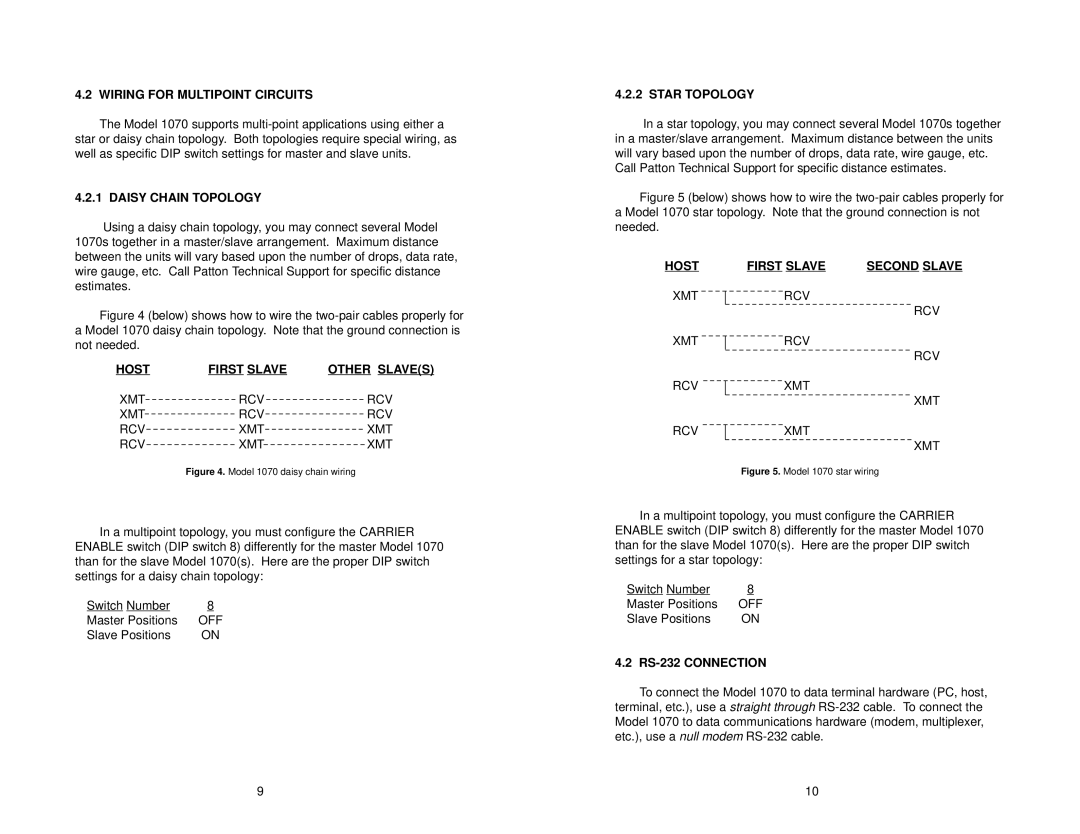
4.2 WIRING FOR MULTIPOINT CIRCUITS
The Model 1070 supports
4.2.1 DAISY CHAIN TOPOLOGY
Using a daisy chain topology, you may connect several Model 1070s together in a master/slave arrangement. Maximum distance between the units will vary based upon the number of drops, data rate, wire gauge, etc. Call Patton Technical Support for specific distance estimates.
Figure 4 (below) shows how to wire the two-pair cables properly for a Model 1070 daisy chain topology. Note that the ground connection is not needed.
HOST | FIRST SLAVE | OTHER SLAVE(S) |
XMT | RCV | RCV |
XMT | RCV | RCV |
RCV | XMT | XMT |
RCV | XMT | XMT |
Figure 4. Model 1070 daisy chain wiring
In a multipoint topology, you must configure the CARRIER ENABLE switch (DIP switch 8) differently for the master Model 1070 than for the slave Model 1070(s). Here are the proper DIP switch settings for a daisy chain topology:
Switch Number | 8 |
Master Positions | OFF |
Slave Positions | ON |
4.2.2 STAR TOPOLOGY
In a star topology, you may connect several Model 1070s together in a master/slave arrangement. Maximum distance between the units will vary based upon the number of drops, data rate, wire gauge, etc. Call Patton Technical Support for specific distance estimates.
Figure 5 (below) shows how to wire the two-pair cables properly for a Model 1070 star topology. Note that the ground connection is not needed.
HOST |
| FIRST SLAVE | SECOND SLAVE |
XMT |
| RCV | RCV |
| |||
XMT |
| RCV | |
| RCV | ||
| |||
RCV |
| XMT | |
| XMT | ||
| |||
RCV |
| XMT | |
| XMT | ||
| |||
|
|
|
Figure 5. Model 1070 star wiring
In a multipoint topology, you must configure the CARRIER ENABLE switch (DIP switch 8) differently for the master Model 1070 than for the slave Model 1070(s). Here are the proper DIP switch settings for a star topology:
Switch Number | 8 |
Master Positions | OFF |
Slave Positions | ON |
4.2 RS-232 CONNECTION
To connect the Model 1070 to data terminal hardware (PC, host, terminal, etc.), use a straight through
9 | 10 |
